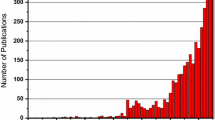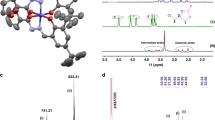Abstract
The coupling reaction of carbon dioxide with epoxides was investigated using naturally occurring α-amino acids as the catalyst in supercritical carbon dioxide and it was found that L-histidine is the most active catalyst. In the presence of 0.8 mol% of L-histidine at 130 °C under 8 MPa of CO2, the reaction of carbon dioxide with epoxides proceeded smoothly, affording corresponding cyclic carbonates in good to excellent yields.
Similar content being viewed by others
References
Beckman EJ. Green chemical processing using CO2. Ind Eng Chem Res, 2003, 42: 1598–1602
Shi M, Shen YM. Recent progresses on the fixation of carbon dioxide. Curr Org Chem, 2003, 7: 737–745
Sakakura T, Choi JC, Yasuda H. Transformation of carbon dioxide. Chem Rev, 2007, 107: 2365–2387
Coates GW, Moore DR. Discrete metal-based catalysts for the copolymerization of CO2 and epoxides: Discovery, reactivity, optimization, and mechanism. Angew Chem Int Ed, 2004, 43: 6618–6639
Shaikh AAG, Sivaram S. Organic carbonates. Chem Rev, 1996, 96: 951–976
Biggadike K, Angell RM, Burgess CM, Farrell RM, Hancock AP, Harker AndJ., Irving WR, Ioannou C, Procopiou PA, Shaw RE, Solanke YE, Singh OMP, Snowden MA, Stubbs RJ, Walton S, Weston HE. Selective plasma hydrolysis of glucocorticoid γ-lactones and cyclic carbonates by the enzyme paraoxanase: An ideal plasma inactivation mechanism. J Med Chem, 2000, 43: 19–21
Xiaoding X, Moulijn JA. Mitigation of CO2 by chemical conversion: plausible chemical reactions and promising products. Energy & Fuels, 1996, 10: 305–325
Lichtenwalter M, Cooper JF. Producing alkylene carbonates. U.S. Patent 2773070, 1956
Paddock RL, Hiyama Y, Mckay JM, Nguyen ST. Co(III) porphyrin/DMAP: An efficient catalyst system for the synthesis of cyclic carbonates from CO2 and epoxides. Tetrahedron Lett, 2004, 45: 2023–2026
Paddock RL, Nguyen ST. Chemical CO2 fixation: Cr(III) Salen complexes as highly efficient catalysts for the coupling of CO2 and epoxides. J Am Chem Soc, 2001, 123: 11498–11499
Jing H, Edulji SK, Gibbs JM, Stern CL, Zhou HY, Nguyen ST. (Salen) Tin complexes: Syntheses, catalytic activity in the formation of propylene carbonate from CO2 and propylene oxide. Inorg Chem, 2004, 43: 4315–4327
Meléndez J, North M, Pasquale R. Synthesis of cyclic carbonates from atmospheric pressure carbon dioxide using exceptionally active aluminium(salen) complexes as catalysts. Eur J Inorg Chem, 2007, 3323–3326
Ji D, Lu X, He R. Syntheses of cyclic carbonates from carbon dioxide and epoxides with metal phthalocyanines as catalyst. Appl Catal A: Gen, 2000, 203: 329–333
Li F, Xia C, Xu L, Sun W, Chen G. A novel and effective Ni complex catalyst system for the coupling reactions of carbon dioxide and epoxides. Chem Commun, 2003, 2042–2043
Shen YM, Duan WL, Shi M. Chemical fixation of carbon dioxide catalyzed by binaphthyldiamino Zn, Cu, and Co salen-type complexes. J Org Chem, 2003, 68: 1559–1562
Jiang JL, Gao F, Hua R, Qiu XJ. Re(CO)5Br-catalyzed coupling of epoxides with CO2 affording cyclic carbonates under solvent-free conditions. J Org Chem, 2005, 70: 381–383
Lu XB, Liang B, Zhang YJ, Tian YZ, Wang YM, Bai CX, Wang H, Zhang RJ. Asymmetric catalysis with CO2: Direct synthesis of optically active propylene carbonate from racemic epoxides. J Am Chem Soc, 2004, 126: 3732–3733
Kawanami H, Sasaki A, Matsui K, Ikushima Y. A rapid and effective synthesis of propylene carbonate using a supercritical CO2-ionic liquid system. Chem Commun, 2003, 896–897
Peng J, Deng Y. Cycloaddition of carbon dioxide to propylene oxide catalyzed by ionic liquids. New J Chem, 2001, 25: 639–641
Kim YJ, Varma RS. Tetrahaloindate(III)-based ionic liquids in the coupling reaction of carbon dioxide and epoxides to generate cyclic carbonates: H-bonding and mechanistic studies. J Org Chem, 2005, 70: 7882–7891
Caló V, Nacci A, Monopoli A, Fanizzi A. Cyclic carbonate formation from carbon dioxide and oxiranes in tetrabutylammonium halides as solvents and catalysts. Org Lett, 2002, 4: 2561–2563
Ako T, Fukai T, Sahashi R. Cycloaddition of oxirane group with carbon dioxide in the supercritical homogeneous state. Ind Eng Chem Res, 2002, 41: 5353–5358
Song J, Zhang Z, Huan B, Hu S, Li W, Xie Y. Synthesis of cyclic carbonates from epoxides and CO2 catalyzed by potassium halide in the presence of β-cyclodextrin. Green Chem, 2008, 10: 1337–1341
Yano T, Matsui H, Koike T, Ishigure H, Fujihara H, Yoshihara M, Maeshima T. Magnesium oxide-catalysed reaction of carbon dioxide with an epoxide with retention of stereochemistry. Chem Commun, 1997, 1129–1130
Yamaguchi K, Ebitani K, Yoshida T, Yoshida H, Kaneda K. Mg-Al mixed oxides as highly active acid-base catalysts for cycloaddition of carbon dioxide to epoxides. J Am Chem Soc, 1999, 121: 4526–4527
Alvaro M, Baleizao C, Das D, Carbonell E, Garcia H. CO2 fixation using recoverable chromium salen catalysts: use of ionic liquids as cosolvent or high-surface-area silicates as supports. J Catal, 2004, 228: 252–258
Alvaro M, Baleizao C, Carbonell E, Ghoul ME, García H, Gigante B. Polymer-bound aluminium salen complex as reusable catalysts for CO2 insertion into epoxides. Tetrahedron, 2005, 61: 12131–12139
Lu XB, Xiu JH, He R, Jin K, Luo LM, Feng XJ. Chemical fixation of CO2 to ethylene carbonate under supercritical conditions: continuous and selective. Appl Catal, A: Gen, 2004, 275: 73–78
Takahashi T, Watahiki T, Kitazume S, Yasuda H, Sakakura T. Synergistic hybrid catalyst for cyclic carbonate synthesis: Remarkable acceleration caused by immobilization of homogeneous catalyst on silica. Chem Commun, 2006, 1664–1666
Sakai T, Tsutsumi Y, Ema T. Highly active and robust organic-inorganic hybrid catalyst for the synthesis of cyclic carbonates from carbon dioxide and epoxides. Green Chem, 2008, 10: 337–341
Du Y, Wang JQ, Chen JY, Cai F, Tian JS, Kong DL, He LN. A poly(ethylene glycol)-supported quaternary ammonium salt for highly efficient and environmentally friendly chemical fixation of CO2 with epoxides under supercritical conditions. Tetrahedron Lett, 2006, 47: 1271–1275
Du Y, Cai F, Kong DL, He LN. Organic solvent-free process for the synthesis of propylene carbonate from supercritical carbon dioxide and propylene oxide catalyzed by insoluble ion exchange resins. Green Chem, 2005, 7: 518–523
Shi F, Zhang Q, Ma Y, He Y, Deng Y. From CO oxidation to CO2 activation: An unexpected catalytic activity of polymer-supported nanogold. J Am Chem Soc, 2005, 127: 4182–4183
Qi C, Jiang H, Wang Z, Zou B, Yang S. Naturally occurring α-amino acids catalyzed coupling of Carbon dioxide with epoxides to afford cyclic carbonates. Synlett, 2007, 255–258
Kawanami H, Ikushima Y. Chemical fixation of carbon dioxide to styrene carbonate under supercritical conditions with DMF in the absence of any additional catalysts. Chem Commun, 2000, 2089–2090
Author information
Authors and Affiliations
Corresponding author
Rights and permissions
About this article
Cite this article
Qi, C., Jiang, H. Histidine-catalyzed synthesis of cyclic carbonates in supercritical carbon dioxide. Sci. China Chem. 53, 1566–1570 (2010). https://doi.org/10.1007/s11426-010-4019-7
Received:
Accepted:
Published:
Issue Date:
DOI: https://doi.org/10.1007/s11426-010-4019-7




